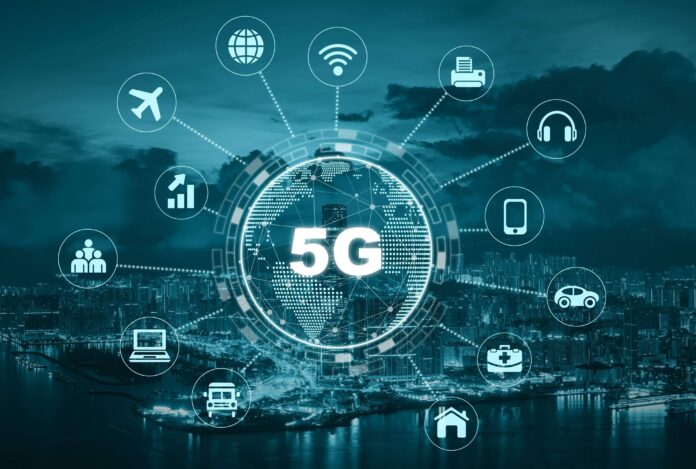5G mobile technology will offer dramatically faster data speeds than the current 4G LTE networks.
Much like 4G, which was introduced in 2009, 5G is a mobile internet standard the infrastructure, and protocols required to transmit large amounts of data over mobile networks.
It’s fast, though not as quick as previous generations of cellular technology (4G offers peak download speeds up to 10 times quicker than 3G). It’ll support greater capacity for devices connected at one time (think hundreds of people connecting at once for virtual reality), and the 5G plans to increase connection speeds by up to 50 times over current levels.
Hang on, what’s 4G?
4G is the fourth generation of cellular mobile communications technology – it enables super-fast data download and uploads in comparison to previous generations (3G and 2G).
It was introduced in Australia around 2009, with users in Melbourne able to access Telstra’s Next G network from December 1 that year. Since then we’ve become accustomed to downloading TV episodes or movies within minutes or even seconds. The initial 4G networks were based on the Long Term Evolution (LTE) standard, now mostly 3GPP-based (the 3rd Generation Partnership Project, which aims to advance mobile technologies).
First-generation 4G was introduced in Australia in 2009. By 2012, 3% of Australian mobiles had 4G capabilities – but it took until 2014 for 56% of people to have access to the technology nationwide. Today about 94% of Australians have access to 4G according to Telstra.
When Will 5G Really Arrive?
5G, is 5th Generation network technology is an ongoing initiative by telecommunications standards organizations worldwide for the future telecommunication networks called 5G.
5G will have a number of improvements with respect to previous generations of mobile wireless standards, including higher data rates for mobile devices, lower latency, and more network capacity. 5G is also known as 5th generation wireless or 5G NR (New Radio).
According to GSA (Government Services Administration), 5G stands at the convergence of different technologies, namely;
- 5G Technology
- Cloud Networking
Over the years, telecommunications has undergone numerous upgrades, each with its own advantages and disadvantages at the time of inception.

The first generation was analog cellular technology that offered voice quality that sounded like a mixture between a walkie-talkie and a telephone system. It did not allow customers to stay on call for very long before having to recharge their batteries.
The second generation also referred to as 2G or D-AMPS (digital advanced mobile phone service), allowed users to increase battery life but still had limited data storage capacity due to technical constraints in this wireless standard.
The third generation is known as 3G or WCDMA (Wideband Code Division Multiple Access) which allowed for greater multimedia capabilities and higher data speeds. It also increased customer satisfaction as well as an improved user experience, but it still suffered from latency issues, i.e., the time it takes to send or receive a signal was delayed due to its inability to process mobile data at faster speeds.
Now that 4G LTE (Long Term Evolution), has been widely deployed throughout much of the world, telecommunications industries around the globe are pushing towards 5G networks with even more emphasis on speed and scalability. The US first began testing 5G wireless technology in 2014 and should begin offering commercial service sometime soon once standards have been set by 3rd Generation Partnership Project (3GPP).

But Now 5G Turn:
5G promises to deliver speeds up to 1 Gbps, a tenfold improvement over 4G LTE’s peak download speed of 100 Mbps. This increase in speed will be accomplished through an increased number of cell sites that can handle more simultaneous connections with smaller distances between them.
It will also allow users to send data packets bigger than the current 4GB files at speeds up to 10 Gbps (gigabits per second), which are faster by far compared to today’s average 3Mbps broadband connection. Suffice it to say, 5G will help bring about highly disruptive technologies such as self-driving cars and the Internet of Things (IoT).
As telecommunications becomes increasingly more convenient, affordable, and easily accessible due to new technology, ramifications arise. It is important to take note of the potential impacts that could result from improvements in 5G wireless technology.
Some Risks Involved:
The possible dangers may be related to security, privacy, and the spread of false information. There are also concerns regarding radiofrequency radiation exposure which can cause side effects such as cancer, insomnia, headaches, fatigue, nausea, DNA breakage, memory fog rants, etc.

People need to understand how their health might be affected by this new technology before it becomes available on a wide-scale basis. The only way to know for sure is through research studies done with 5G networks in operation across the globe over the next few years.
Some Positive Effects:
On the flip side, 5G technology has the potential to positively impact business, economic and social growth. With faster speeds, cloud computing will be able to provide convenience in our daily lives. For example, cars that drive themselves will rely on 5G networks for communication between vehicles and infrastructure.

Hospitals would become more efficient with access to real-time medical diagnoses of remote patients. A higher amount of bandwidth means a greater number of devices can connect at once without slowing down network performance. This will allow more people to simultaneously use their mobile devices or smart home appliances thus creating an improved customer experience.
Telecommunications industries are constantly changing due to advancements in wireless communications technology. As soon as one generation becomes widely adopted by users around the world, new and improved devices will be developed that rely on newer and faster networks.
This post was originally published on 17, November 2021, but according to new information stuff, this post is updated frequently.
Editor Recommendations:
>What is 4K (Ultra HD)? Explained

